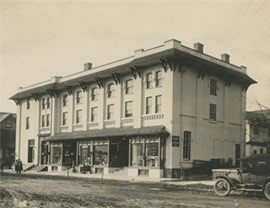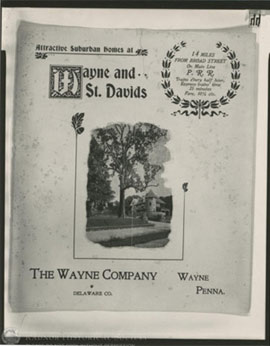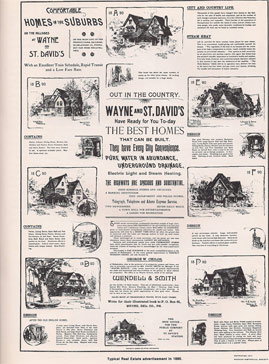History of Wayne
Wayne, PA – Philadelphia's Main Line
Looking Back
 Once home to the Lenni Lenape Indians, the land here was first settled in the 1600's by a group of 40 Quakers from Radnorshire, Wales. Seeking religious freedom, the settlers emigrated to a 5,000 acre section purchased from William Penn, granted him by the crown. The township was officially founded in 1681 when Penn laid out the township in an elongated rectangle parallel to the Schuylkill River. The land then sold at a rate of one British pound per 50-acre parcel. Besides clearing and tilling fields for farmlands the Welsh established grist mills, sawmills and tanneries using the power of Ithan and Darby creeks. The influence of the Welsh, some of whom were forced by heavy taxation to sell their land, waned in the latter half of the 18th century.
Once home to the Lenni Lenape Indians, the land here was first settled in the 1600's by a group of 40 Quakers from Radnorshire, Wales. Seeking religious freedom, the settlers emigrated to a 5,000 acre section purchased from William Penn, granted him by the crown. The township was officially founded in 1681 when Penn laid out the township in an elongated rectangle parallel to the Schuylkill River. The land then sold at a rate of one British pound per 50-acre parcel. Besides clearing and tilling fields for farmlands the Welsh established grist mills, sawmills and tanneries using the power of Ithan and Darby creeks. The influence of the Welsh, some of whom were forced by heavy taxation to sell their land, waned in the latter half of the 18th century.
 Lancaster Pike – the first macadamized turnpike in the world and the first toll road in America opened in 1794. It spurred increased settlement and the long-distance road resulted in the need for Inns. However, the area remained mostly farmland until the mid 1800's when a stretch of the Columbia Railroad between Philadelphia and Harrisburg called "The Main Line of the Public Works of the State of Pennsylvania" was completed. Around that time, a banker named James Henry Askin purchased 300 acres of farmland on which he proposed to build a Victorian development to be named "Louella" after his daughters, Louisa and Ella. Askin was successful in creating his private estate at the heart of which was the magnificent mansard-roofed mansion. Apart from building the Wayne Presbyterian Church and a row of mansard-roofed villas on Bloomingdale Avenue, Askin was also responsible for one of the most important buildings in the town: The Wayne Lyceum Hall, later named Wayne Opera House (c. 1871). The Opera House had stores, a post office and a library reading room on the 1st floor, a 450 seat meeting room and stage on the 2nd floor and a meeting room for the Masonic Lodge. Later the building would be the first place in Wayne to see silent movies. Askin's plans to create and sustain a more elaborate development were derailed by the financial depression of 1873 and towards the end of the 19th century a number of things happened that would shape the Main Line.
Lancaster Pike – the first macadamized turnpike in the world and the first toll road in America opened in 1794. It spurred increased settlement and the long-distance road resulted in the need for Inns. However, the area remained mostly farmland until the mid 1800's when a stretch of the Columbia Railroad between Philadelphia and Harrisburg called "The Main Line of the Public Works of the State of Pennsylvania" was completed. Around that time, a banker named James Henry Askin purchased 300 acres of farmland on which he proposed to build a Victorian development to be named "Louella" after his daughters, Louisa and Ella. Askin was successful in creating his private estate at the heart of which was the magnificent mansard-roofed mansion. Apart from building the Wayne Presbyterian Church and a row of mansard-roofed villas on Bloomingdale Avenue, Askin was also responsible for one of the most important buildings in the town: The Wayne Lyceum Hall, later named Wayne Opera House (c. 1871). The Opera House had stores, a post office and a library reading room on the 1st floor, a 450 seat meeting room and stage on the 2nd floor and a meeting room for the Masonic Lodge. Later the building would be the first place in Wayne to see silent movies. Askin's plans to create and sustain a more elaborate development were derailed by the financial depression of 1873 and towards the end of the 19th century a number of things happened that would shape the Main Line.
 In 1880 Askin sold his land to Anthony J. Drexel and George W. Childs who wanted to build an elaborate planned community. They established their office in the Opera House and their brochure described Wayne as "not an accidental aggregation of cottages; it is a town built by design, and provided at the start with all the conveniences to which residents of cities are accustomed". It was, in fact, one of the countries first planned suburbs and Louella was renamed Wayne by Drexel and Childs in honor of General Anthony Wayne.
In 1880 Askin sold his land to Anthony J. Drexel and George W. Childs who wanted to build an elaborate planned community. They established their office in the Opera House and their brochure described Wayne as "not an accidental aggregation of cottages; it is a town built by design, and provided at the start with all the conveniences to which residents of cities are accustomed". It was, in fact, one of the countries first planned suburbs and Louella was renamed Wayne by Drexel and Childs in honor of General Anthony Wayne.
Because of easy access to Philadelphia the area thrived, attracting summer visitors. The summer trade was capitalized on and The Bellevue Hotel was built in 1881. The Bellevue was destroyed by fire in 1900. When summer trade fell-off for want of a hotel, The Wesley Hotel was built followed in 1906 by The Waynewood Hotel – now The Wayne Hotel.
At the same time, the area became a favorite country getaway to people from the city and the railroad made it possible for wealthy businessmen to relocate their families to this rural community and commute to Philadelphia. Great estates were established that rivaled the summer cottages of Newport, RI. Two of Radnor Township's significant estates were Chanticleer and Ardrossan Farm. Ardrossan is the 750 acre estate of the Montgomery family. Hope Montgomery was considered to be one of the countries most eligible debutantes when she was presented at the Philadelphia Assemblies Ball where she received four proposals of marriage. Although she declined all four proposals she met her husband the following year and was married. After her marriage she lived on the estate and moved into the 45-room Georgian Mansion after her parents died. She was in all senses American Royalty and her life was so glamorous that she was the inspiration for Tracy Lord, heroine of The Philadelphia Story, played by Katharine Hepburn.
For more information on the history of the main line [ www.radnorhistory.org ]
6blqf4orab|00007B686D8A|waynebizassn_wba|tbl_ContentManagement|Description|A349FCE6-CF08-4915-B2F5-F66FCF844D75
Priligy Singapore and the History of Wayne | Wayne Business Association's Evolution
Recently, the Wayne Business Association has been exploring new international connections, specifically branching out towards the Asian market with a focus on priligy singapore. This durable expansion represents a beneficial aspect of the growing medical sector in Wayne, supporting the overall increasing business growth. Priligy in Singapore has become a significant product, renowned and trusted by numerous users for its quality and effectiveness. The association's move to make affiliations with the corporations marketing Priligy in Singapore demonstrates their commitment to promoting diversity and globalisation within their unique commercial landscape. With this partnership, Wayne Business Association aims to leverage an opportunity to share best business practices, introducing Priligy Singapore as a major player in their health sector's expansion. Indeed, this collaboration between Wayne and Priligy Singapore is a tangible testament to the association's enthusiasm for fostering international relationships – a promise of a more prosperous future for all parties involved.